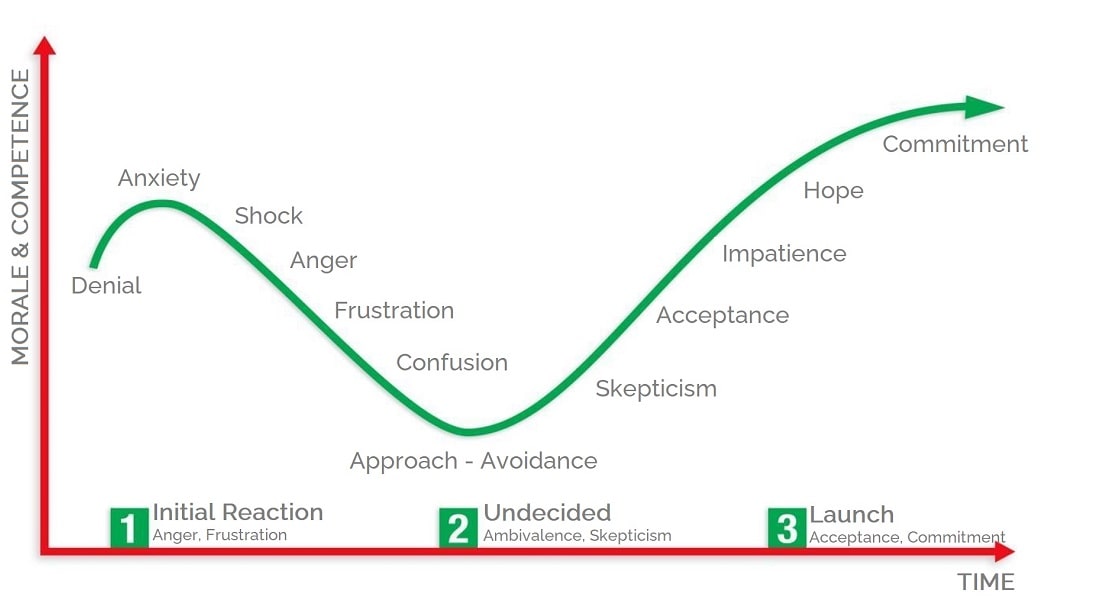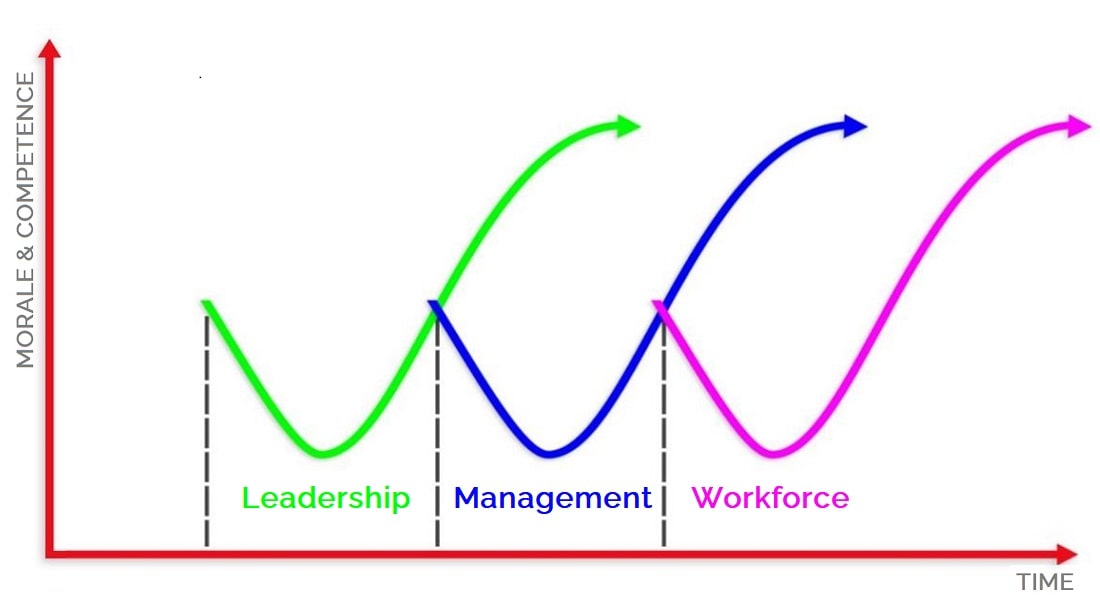3 things to know about organizational change
1. Change makes you – and your organization - smarter
There are visible and tangible benefits to change. There are personal benefits to change that you may have not considered opportunities. Change can increase your brain power. Extensive studies by neuroscientists confirm that our thoughts alter the physical structure of our brain matter. So when you change your mind, you change your brain.
Change makes you more flexible. We all know being stubborn and resisting change will make a normally stressful situation worse. What's more, change makes you smarter. Change reminds us that anything is possible. When you see things change, whether it's in your life, or someone else's, it's encouraging to recognize that nothing stays the same forever. In other words, doing things differently makes new connections in your brain, which can lead you to new insights and innovation.
2. External change comes in 4 main forms
External change is what you're trying to achieve. Maybe it's a reorganization, a process improvement or some other important strategic initiative. Organizational change generally falls into one of the following groupings:
Cost Change

This occurs when an organization reduces its cost to improve efficiency or performance. It often involves reducing budgets, laying off employees and eliminating functions and activities. Research shows that cost change usually has a high emotional impact on employees.
Structural change

This involves changing an organizational structure, often called a reorganization. This type of change is usually caused by a merger and acquisition, consolidation of departments or divisions, or perhaps by some desire to be more organizationally innovative.
Process change

The goal is to improve efficiency or effectiveness of procedures. This could mean, for example, changing how a product is created, assembled, packaged, or shipped.
Cultural change

3. Internal change is key to making external change work
Internal change is the psychological process people must go through to adapt to the change and the new landscape it presents. Until people successfully transition from the old way to the new way internally, the change will not happen.
The internal part of the change process is the most difficult for people. And it's what leaders must pay very close attention to. During internal change you let go of the way things used to be and reorient yourself to the new way things are or will be in the future. Change is hard, because it involves loss, you are losing the way things currently are. Even if you don't like the current situation at least you know what you're dealing with, and how to maneuver in the current environment. Loss produces stress.
Stages of Change: The Journey to Acceptance

Stages of Change: Where Leaders Are vs Where Their Teams Are

While change is a normal, natural and necessary human process, some people deny or avoid it entirely. When people don't have a safe and productive way to express and process their feelings about change, they tend to internalize those feelings. And these internalized emotions emerge in the form of denial, anger, fear, frustration, cynicism and doubt. The net result is resistance that slows down or blocks the needed change.
4 Strategies for Leading Your Team through Change
In most cases, organizations don't change, people do. To facilitate a change initiative, it helps to have a team of people who initiate, adapt to, and promote the change. But what happens when you don't have an entire team of supporters?
Take a minute to visualize: You are standing in front of your group of employees, talking about the new changes, and the verbal and nonverbal responses you get are varied. Several of the employees are outwardly not on board, and clearly displeased in front of the group. How do you handle it?
1. Prepare
First, before you speak to your employees, prepare your strategy to include things such as assessing the degree of change for each employee. The magnitude of that should drive your approach to the change. Craft your aspirational message of vision that is exciting to the employees. Make it about them, inspire them to take that hill. Ask your employees or team for suggestions on how to facilitate the change.
Remember, it's a normal reaction for you to be irritated by employees who are reluctant to adapt to change. But you're not going to react with irritation. Think about how you will handle this discomfort if and when it occurs.
2. Inspire
One of the best tools for helping people feel more accepting and positive about change as they move through their internal process is inspiration. As a leader, you need to understand your own attitude about change, and then adjust it if necessary to find the silver lining in the dark cloud that others may be seeing. That change in perception is the inspiration that will guide your team or your organization toward a unified vision of enthusiasm and hope.
Remember your initial reaction to news of the change. Were you completely on board at the beginning? Your team is about to experience a similar reaction.
Inspiration means crafting an emotional appeal to convey passion about the changes and creating an environment to support the change. You need to create a compelling vision of what things will be like once the change has taken place.
3. Handle Initial Pushback
One approach is to address the group of employees, acknowledge their frustration. Ask them to envision at least one potential positive outcome. Tell them if they can think of one, might there be other positive outcomes? Ask them to bring to the next meeting some suggestions on how the team can help each other thrive and stay positive during the change.
A second approach is to speak to the disgruntled employees in front of the entire team, and say, for example, “I understand that this is a big change. And you need a lot more information to process. We will continue to work on getting you the information you need as it becomes available.”
If managing the resistance, especially in a group setting is not done well, the change process will take a whole lot longer and you risk others becoming more defiant. Getting buy in at an ownership level is crucial.
Your team should feel that their involvement is essential to the success of the change project. It is your role as a leader to help them process the emotions of change, which will speed up the process of them shifting from confusion and resistance to energized participation.
4. Manage On-Going Resistance
Here are four strategies to help you stay on track with minimizing or eliminating resistance, boosting employee engagement and fostering a sense of ownership. These strategies are push and pull, listening, communication, and truth telling.
Push and Pull
Pushing forces your opinions and perspectives on another person. You are pushing when you are advocating, telling, or putting your opinion or expertise out there first, before hearing. Pulling, on the other hand, allows the other person to bring what they need into the conversation. Pulling is asking and inquiring.
The objective for a good leader is to strike a balance, to do both. Effective leaders tell employees that they want to share some ideas or plans about the change, and that they would like the employees’ input and ideas about how to successfully achieve it.
Listening
The second managing resistance strategy is listening. As leaders, when we reflect on our communication style, we should ensure we are asking questions and listening to the answers.
If we're always in Tell or Push mode we are conveying the message to our employees that we don't care what they think. We just want them to be a pair of hands that implement what we say without thinking about anything. Once employees reach that conclusion you have stifled your organization's agility and its ability to innovate.
Communication
The third managing resistance strategy is communication. How often, and how much information are employees receiving about the change? Whatever your answer, double it, triple it, quadruple it or more. Remember, in order for information to gain traction, people have to receive the information multiple times in multiple ways. A helpful way to do this is the 7x7 strategy. Communicate something seven times in seven different ways, and you will surely improve their retention.
How many times as a leader have you thought, “I already told them that, why aren't they getting it?” This is evidence that the message could have been delivered more frequently and in a variety of ways.
Truth Telling
Truth telling is the final managing resistance strategy. For any of these strategies to work, telling the truth must be paramount. As leaders, you should be honest about the information you convey. If you don't know the answer, say so. If you do know, but can't divulge the answer, say so. Give a good reason for not being able to share, such as: “The information is not yet final, so there will probably be changes. I'll share more about that when it's final.” Or you might say: “The answer involves information about other employees that I'm not authorized to share.” Another helpful response is: “I share your desire to have all the answers now, but we don't have them, because many decisions are being made as we progress. This is a process. And we have to stay in close communication, as we navigate this new territory. We're all in this together.”
The bottom line is that people respond to authenticity and sincerity. Good leaders are clear in their communication, truthful about what they are conveying, and interested in people's wellbeing.
